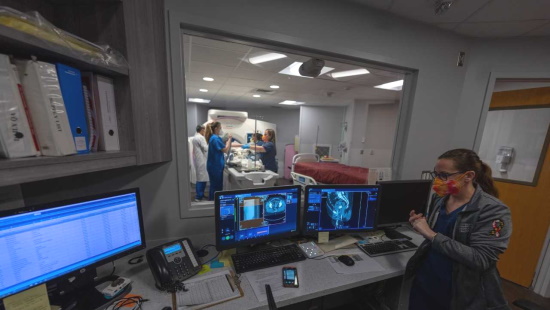
Combined Therapies

At the University of Maryland Department of Radiation Oncology, our mission is to put cancer behind you, so that you can go on to live a long, healthy life.
Combined therapies, which is when we use two therapies that research has shown work effectively together in specific circumstances, are a safe option that can decrease the length of your treatment and improve quality of life.
Proton Therapy and Hyperthermia Therapy
Hyperthermia therapy works by gently heating tumors, making the cancer cells more vulnerable to radiation therapy treatments. In clinical studies, adding hyperthermia therapy to radiation treatments can significantly shrink tumors and improve survival. Treatments are non-invasive with minimal side effects, take 60 minutes, and are given two times a week for the duration of your radiation therapy.
Proton therapy uses protons instead of X-rays to deliver the maximum dose of radiation possible directly to solid, localized tumors with pinpoint precision and without affecting healthy tissues.
Deep-tissue hyperthermia at the Maryland Proton Treatment Center (MPTC) is useful for treating tumors that are located deep within the body, including in the bladder, rectum, cervix, ovaries and pancreas. Treatments that combine hyperthermia with proton therapy are usually given on the same day within one hour of each other. MPTC is the only facility in the U.S. to house proton therapy and hyperthermia under one roof.
External Beam Radiation Therapy and Hyperthermia Therapies
Superficial hyperthermia is used at the University of Maryland for treating patients who have breast cancer or other tumors that are near the surface of the body. It is also beneficial during reirradiation, which is when we treat areas of the body that have previously received radiation therapy.
Deep-tissue hyperthermia is helpful for treating tumors deep inside the abdomen or pelvis. This noninvasive treatment helps make traditional external beam radiation therapy more effective with minimal side effects.
Brachytherapy and Interstitial Hyperthermia
Brachytherapy is a procedure that uses catheter tubes to place tiny radioactive beads directly at the tumor site.
Similar to hyperthermia combined with external therapies, interstitial hyperthermia can directly target the tumor using the same catheter through which the brachytherapy is delivered. It increases the effectiveness of the radiation. This combination is used for larger tumors, or in the reirradiation setting.
External Beam Radiation and Brachytherapy for Prostate or Gynecological Cancers
Sometimes, combining brachytherapy with other types of radiation therapy can be more effective in shrinking tumors and destroying cancer cells, resulting in shorter treatments, fewer side effects and better outcomes.
Men with advanced-stage prostate cancer can benefit from a combination of external beam radiation therapy and prostate brachytherapy. For men with aggressive prostate cancer, rates of success when these two treatments are combined are superior.
Proton therapy combined with brachytherapy can offer a more effective treatment approach with fewer complications, while protecting healthy tissues.
Brachytherapy has been shown to be effective for men with prostate cancer, targeting the tumor directly from inside the prostate.
The University of Maryland is a regional referral center for complex gynecologic cancer procedures, including one treatment where temporary catheters are placed directly at the tumor site. Combining gynecologic brachytherapy with traditional photon (external beam) radiation therapy or proton therapy has been shown to safely and effectively treat cervical cancer.
Proton Therapy and GammaPod
The GammaPod, invented by University of Maryland doctors and scientists, has been used for early-stage breast cancer since it first received FDA clearance in 2017. Because it was developed right at UMMC, we were the first facility in the world to use this novel technology.
The GammaPod has many benefits to patients, including shorter treatment times, fewer treatment sessions, fewer cosmetic side effects, greater comfort levels during treatment, and possible prevention of cancer recurrence.
For patients with more advanced breast cancers, the GammaPod can be used as a portion of your radiation therapy treatment which can overall shorten the course of therapy.
Make an Appointment
To make an appointment at UM Greenebaum Comprehensive Cancer Center in Baltimore, please call 410-328-6080. Or, contact one of our other five radiation oncology locations in Central Maryland, Eastern Maryland, and Prince George’s County.



